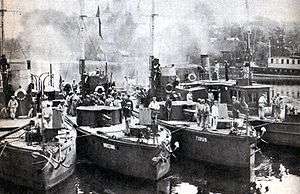River monitor
River monitors were heavily armored, and normally mounted the largest guns of all riverine warships. The name originated from the US Navy's USS Monitor, which made her first appearance in the American Civil War, and being distinguished by the use of revolving gun turrets.
On 18 December 1965, the US Navy, for the second time in one hundred years, authorized the reactivation of a brown-water navy for riparian operations in South Vietnam. In July 1966, Secretary of Defense Robert S. McNamara authorized the formation of a Mobile Riverine Force (MRF);[1] a force that would bring back the heavily armored single-turret river monitor.
River monitors were used on inland waterways such as rivers, estuaries, deltas and lakes. Usually they had a shallow draft which was necessary for them to be able to operate in enclosed waters; but their displacement, size and draft varied depending on where they were used.
Most river monitors were lightly armored although this varied, with some carrying more armor. Exceptional examples, however, most notably the Royal Navy's Lord Clive-class monitors, which could operate in coastal or certain riparian/estuarine situations, bore extra-thick armor plating and heavy shore-bombardment guns, up to a massive 18-inches (457 mm) in size. Typically, however, river monitors displayed a mixture of gun sizes from 3-inch (75 mm) to 6-inch (152 mm), plus machine guns. This type of vessel overlaps with the river gunboat.
Asia
On Asian rivers, the Amur Military Flotilla on the Amur used large Taifun-class river monitors of the Imperial Russian Navy from around 1907; the Imperial Japanese Navy captured some of these ships in 1918.[2][3] They were up to 1,000 tons displacement, armed with 130 mm guns. Some of these Russian monitors, such as the recommissioned Sverdlov, were still in use by the Soviet Navy in the 1945 Soviet invasion of Manchuria.[4]
During the Vietnam War, the United States Navy, in conjunction with other riverine craft, commissioned 24 Monitors, ten of which mounted a single 40mm cannon in a Mk 52 turret, eight which mounted an M49 105mm Howitzer within a T172 turret,[5] and six Monitors which mounted two M10-8 Flamethrowers from two M8 turrets located on either side of the vessel's 40mm cannon. Referred to as "River Battleships"[6] by their men, they provided the firepower of the Brown-water navy.
Europe

On the Danube, river monitors were employed during World War I by Austria-Hungary, then by Hungary, Romania and Yugoslavia (approximately 500 tons displacement). Smaller monitors (70-100 ton displacement) were used by Poland in 1939 on the Pripyat River and by the Soviet Union in 1941 on the Pripyat and Dnepr rivers. Hungary used smaller monitors PM-1 class and lightly armored fast patrol crafts Őrnaszád class during World War II (1941: Balkans, 1944: Hungary) as scout, fire support, fast minelaying PAM-21 class and anti-aircraft ships.
United States

River monitors were used during the American Civil War, playing an important role in the Mississippi River Campaigns. They also played a role in the Battle of Mobile Bay. The American Civil War river monitors were very large, weighing up to 1,300 tons.
During the Vietnam War, the US Navy's Brown Water Navy, operated its Monitors as part of their River Assault Flotilla One, which "initially" consisted of four River Assault Divisions (RAD); with RAD 91 containing 3 Monitors, RAD 92 having 2 Monitors, RAD 111 having 3 Monitors, and RAD 112 operating 2 Monitors.[7]
The Vietnam Monitors were divided into two programs; program 4 would consist of the 40mm gun Monitors, while the later program 5 would entail the eight Monitor (H) Howitzer versions, and the six Monitor (F) Flamethrower models.[8] All of the Monitors were converted from World War II 56' long all steel Landing Craft Mechanized (LCMs) Mk 6's.[9] When completed, they were 60' long, 17' wide, with a draft of 31⁄2', had two screws driven by two Gray Marine model 64NH9 diesel engines, could do 8.5 knots and were manned by usually 11 or more crewmen.[10] They usually carried about ten tons of armor.


| US Navy Brown Water Navy River Monitors (Vietnam)[12] | |||
|---|---|---|---|
| Generation-One Type | Generation-Two Type/Flame | Generation-Two Type/Howitzer | |
| Length | 61 ft. | 60 ft. 6 in. | |
| Width | 17 ft. 6 in. | ||
| Draft | 3 ft. 6 in. | ||
| Engines | 2 Gray Marine 64HN9 Diesels; 220 hp @ 2100 rpm | ||
| Speed | 8.5 knts | ||
| Crew | 11 | ||
| Armament |
|
|
|
See also
- Monitor (warship)
- USS Monitor
- Brown Water Navy
- Gunboat
- List of monitors of the United States Navy
- List of monitors of the Royal Navy
- List of monitors of the Swedish Navy
- List of monitors of the Netherlands
References
- ↑ Carrico, p. 11
- ↑ See Soviet Union Monitors Warships of World War II. Retrieved 25 August 2015.
- ↑ Tayfun river gunboats (monitors) (1910). Navypedia. Retrieved 25 August 2015.
- ↑ Glantz, David (2004) Soviet Operational and Tactical Combat in Manchuria, 1945: 'August Storm'. Routledge, p. 222. ISBN 9781135774783
- ↑ Carrico, p. 27
- ↑ Carrico, p. 20, 21, 63
- ↑ Carrico, p. 12
- ↑ Carrico p. 63
- ↑ Carrico, p. 16, 17
- ↑ Carrico, p. 63
- ↑ Carrico p. 82
- ↑ Monitor Specifications, U.S. Navy Mobile Riverine Force, http://www.mrfa.org/Monitor.specs.htm
- Carrico, John M., Vietnam Ironclads, 2007; Brown Water Enterprises. ISBN 978-0-9794231-0-9.
- Friedman, Norman, U.S. Small Combatants: An Illustrated Design History, 1987; Annapolis: Naval Institute Press. ISBN 0-87021-713-5.
- Kramer, Charles (Illustrator), Popular Mechanics Magazine, 1967; Charles Kramer of Zik Assoc., Ltd. cutaway view of Vietnam "River Battleship".